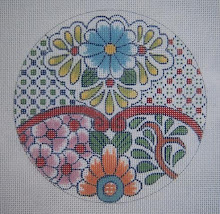 I'm a day late posting this, as I had a computer disasater requiring my son and son-in-law's attention, as I am a dummy on this machine. (I had to threaten total meltdown/running away to Florida to get their immediate attention). Anyway, I have this showing, with complete explanation and some other tiles also, on the other blog, Possibilities, Etc.!
I'm a day late posting this, as I had a computer disasater requiring my son and son-in-law's attention, as I am a dummy on this machine. (I had to threaten total meltdown/running away to Florida to get their immediate attention). Anyway, I have this showing, with complete explanation and some other tiles also, on the other blog, Possibilities, Etc.! I have only stitch drawn the parts of it that I feel necessary, both for symmetry and for matching up where the tiles meet to form the bigger pattern. It is, after all, a totally handpainted ceramic, and making the entire piece stitch painted would make it to nearly "perfect."
 The individual tile itself is 4 1/2" square, but I like to add two threads between the tiles to resemble grout. Also, drawing 3 threads around the entire piece looks rather nice, which adds to the dimension for a total of about 5" for one tile. When you cut canvas, be sure to have enough room for margins for whatever format you want to use.
The individual tile itself is 4 1/2" square, but I like to add two threads between the tiles to resemble grout. Also, drawing 3 threads around the entire piece looks rather nice, which adds to the dimension for a total of about 5" for one tile. When you cut canvas, be sure to have enough room for margins for whatever format you want to use.The easiest way to begin is in the lower right corner. Where you see the arrow, I counted up 27 diagonal stitches, marking them in blue so you can see. You can dot these marks out later with white acrylic paint so they won't show through when stitching a white background.
On the 28th stitch make the first dot for the dividing element.
 Again, the arrows point to significant features. You can pretty well just follow the dots to start the drawing. Blue is used again to show how many spaces to leave between the corners of the element. (6) At the arrow at the top right, you can see where, if you have counted and dotted correctly, the last dot should match up with the side of the tile you started with.
Again, the arrows point to significant features. You can pretty well just follow the dots to start the drawing. Blue is used again to show how many spaces to leave between the corners of the element. (6) At the arrow at the top right, you can see where, if you have counted and dotted correctly, the last dot should match up with the side of the tile you started with. BE SURE to have a little bottle of white acrylic paint handy - one does make mistakes, especially when trying to do this at night and tired. I ruined two canvases before I got it right. If it were just for me, I would just dot out the mistakes in white, but it showed too much to use it here.
The next illustration is showing ending the count correctly at the top, where you can then go ahead and draw the entire square - as I did at the lower left. I thought I could do this count in reverse after stitch counting the first half, but kept going the wrong way and making a mess - so I finally had to just make a mirror image copy to work from. You can work from this one without having to do that.
 The flowers are stitch drawn, as is the element you see at the top left because these need to be on the same thread in order to match up when the tiles are side by side on the canvas - no matter what format you use to "set" them. It just looks nicer for needlepoint.
The flowers are stitch drawn, as is the element you see at the top left because these need to be on the same thread in order to match up when the tiles are side by side on the canvas - no matter what format you use to "set" them. It just looks nicer for needlepoint.

The completed drawing on canvas has orange on it, (The Sharpie ultra-fine Paint Pen) to show me, if I decide to stitch this one, where the orange is. The other parts of the tile are flat color. I rarely paint anything I'm going to stitch myself.
This tracing (on tracing paper) looks a little rough, as I did it directly from the canvas.
You might need to go over it with a black felt tip pen to make it easier to see through your canvas when you're ready to draw it. Just count the design parts that need to be done first, and then trace the leaves and the yellow flower from the picture.

Enjoy! and maybe with a bit of confidence and know-how now you can design your own tiles. There are detailed instructions for drawing on canvas (canvas preparation) on this blog - so do refer to them if you need to.

No comments:
Post a Comment